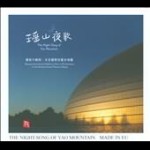It’s not often that North American audiences get the chance to hear a world-class children’s choir perform in concert, especially one from Europe, Asia, or Africa. If you have had the pleasure, you understand that “children” is just a convenient name, and first-rate music-making is not the province of only professional adults or a small contingent of prodigies. No, as you will hear, these young singers–ages 9-16, selected by audition from schools in Beijing–are capable of sophisticated ensemble performance, and are as understanding of expressive nuance as they are skilled in vocal technique.
The program “takes us on a magical journey through China”, including the regions of Guizhou, Shandong, Guangxi, and Beijing, but also features songs of many of the country’s ethnic people–the Yao, the Jing, the Han, and others. Most of the material consists of folk tunes, set in modern arrangements, but there also are some original songs that enjoy popularity across China.
The voices are lovely, bright, and (mostly) very well-tuned–there are several moments that seem intonationally fatigued–the tunes are very attractive, the harmonies vibrant (lots of thirds and sixths!), the unison singing the envy of any choir director. But lest you think this is nothing more than a nice, sweet collection of child-songs, you will be surprised when you hear the choir shift from a lilting, dreamy mood in the beginning of “The Night-Song of Yao Mountain”, then suddenly jump into a dance, then back again, concluding with a percussive handclap and final swirling cry. This is followed immediately by the “Song of Picking Vegetables”, a very rhythmically tricky a cappella piece, impeccably sung with colorful, often subtle inflection and conveying the song’s humor even to a listener who doesn’t understand Chinese! The same expressive effectiveness follows in “Hammock Hanging Between Betel Trees”, a traditional Jing nationality folksong whose music perfectly depicts its subject–and is affectingly realized by the choir. Perhaps the most demanding ensemble pieces are the Tujia folksong “Dong Dong Kui” and the Yunnan “Riddle Song”, which demand ultimate attention to details of quick-shifting tempos, rhythms, and expressive effects.
There’s much more here–and the liner notes do a fine job of enlightening us regarding the subject and origin of each song–including some lovely tunes that will appeal to everyone who likes popular and folk music. The arrangements place the purity and simplicity of these songs–and the children’s voices–to the fore, and the engineering does nothing more than complement the singers and music–no electronic tinkering or “enhancement”. Whether you’ve heard a great children’s choir before–or Chinese folk music, for that matter–you should not hesitate to try this. Not only is the singing wonderful, but the music will likely alter some long-held impressions. Strongly recommended. [9/27/2010]
































